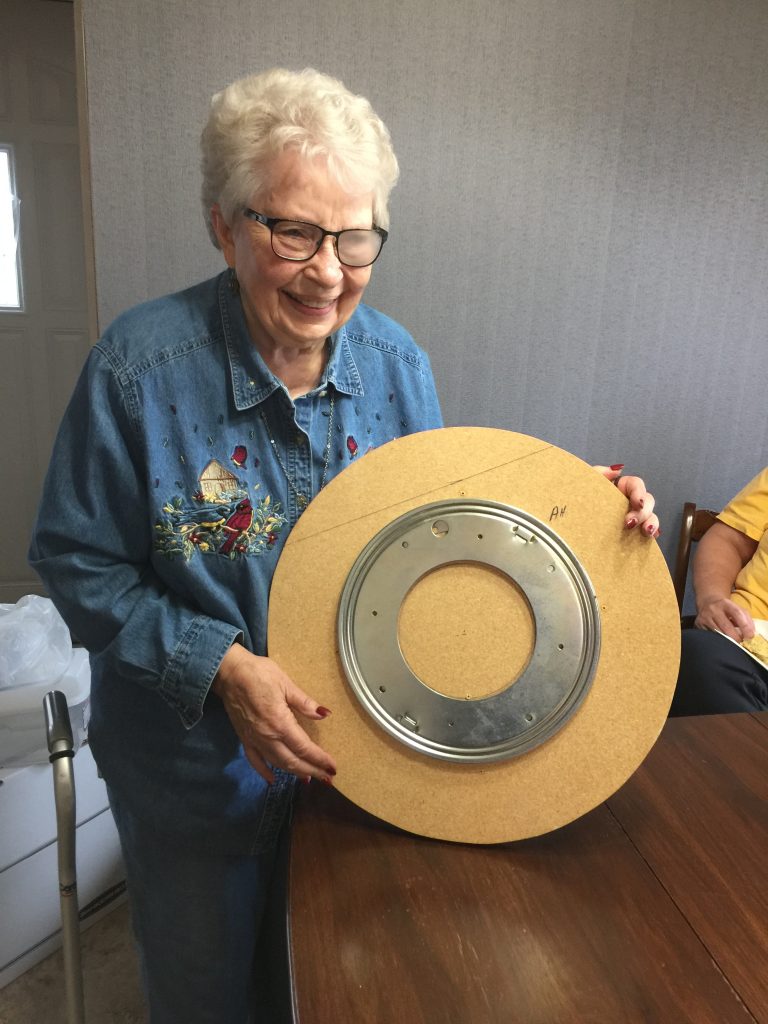
I learn from every lefse maker I meet. A little tip, a refinement in the recipe or way of making lefse, perhaps a joke or a song. It keeps lefse making fresh for me, and I make a lot of lefse friends.
I met a lot of lefse makers when I spoke at the Sons of Norway Vennekretsen Lodge in Anoka, Minnesota. One of them was Alice Holland, who handed me a paper with two photos on it and her phone number. A few days after my presentation, I called Alice and she explained the photos and how she made her own lefse pastry board with Lazy Susan hardware attached to the bottom. I was intrigued.
“In 1986, I had a back injury,” Alice said, “and it’s difficult for me to twist my back.” In 1990, during a kitchen remodeling project, workers cut a hole in the countertop material to make room for the kitchen sink. The hole was 19 inches across, and Alice the lefse maker immediately seized the cutout piece for use as a lefse pastry board for rolling lefse. And because of her back issue, she fixed to the board Lazy Susan hardware she purchased from The Home Depot.
“With that, I don’t have to twist my back when I roll lefse,” Alice says. “Just rotate the board with a little push of my thumb.”
I decided to give Lazy Susan lefse making a try. I realized how much I bend and twist and dance around my pastry board as I adjust the angle of my rolling pin in order to roll round rounds. I often rotate the board because I move around the perimeter of the board when rolling. Because I’m not grinding on the same spot in the middle of the board, I reduce the amount of flour used—which makes for more tender lefse—and it prevents the dreaded sticking problem.
I used to add rubber feet to the Keep On Rolling Pastry Board that I sell, but I have removed the feet because it’s easier to rotate the board without them. Using a Lazy Susan lefse board would make it even easier to rotate the board.

To make a Lazy Susan lefse pastry board, I purchased at Menards a 12-inch Lazy Susan by Shepherd Hardware Products. A true Lazy Susan would attach the lefse pastry board to a base board. I decided not to attach my rolling board to a base board because it would require drilling through the rolling board. I didn’t want holes and screw heads messing up the surface of my rolling board. I also didn’t want the extra weight and clunkiness that would come with a second board.
So I simply used No. 8 x 1/2-inch flat head wood screws to attach the Lazy Susan to the bottom of my board I have used for years. I had to use flat head screws; round head screws would prevent the Lazy Susan parts from moving freely. My board is 1/2 inch thick but the 1/2-inch screw don’t poke through to the rolling surface because the thickness of the Lazy Susan hardware stop the screws from sinking a full 1/2 inch.
After attaching the hardware to the board, the last detail was cutting a piece of perforated rubber used for shelf matting and placing that on my countertop and under my pastry board. I didn’t want the Lazy Susan Hardware to scratch my granite countertop.
Viola! I can roll lefse and rotate my rolling board with ease so I can keep on rolling for years with less work. Thanks, Alice!
